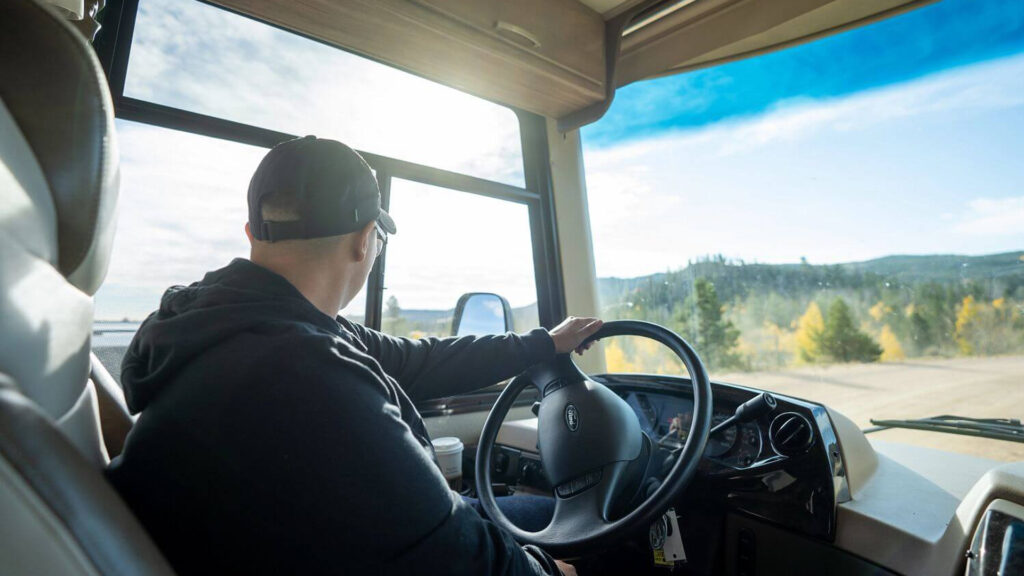
The Ultimate Guide to Driving RV: Tips for a Smooth Journey
Table of contents
- Understanding Different Types of RVs
- Basic Driving Techniques for RVs
- Navigating Challenging Road Conditions
- Parking and Maneuvering Your RV
- Safety Considerations for RV Driving
- Tips for Long-Distance RV Travel
- Driving RVs Through Tunnels and Bridges
- Legal Considerations and Regulations
- Secure Your RV Journey with Custom Skirting
- Related Articles
Embarking on a journey in an RV is the epitome of freedom and adventure. Whether you’re a seasoned traveler or new to the RV lifestyle, the allure of the open road and the ability to bring the comforts of home with you make RV travel increasingly popular. However, driving an RV can be daunting, especially for first-timers. This comprehensive guide will equip you with the knowledge and confidence you need to navigate the roads safely and enjoy your RV experience to the fullest. We’ll cover everything from understanding different types of RVs to RV driving tips. By the end of this guide, you’ll know exactly how to drive an RV, tackle challenging road conditions, and handle your vehicle with ease.
Understanding Different Types of RVs
Before diving into the driving RV tips, it’s crucial to understand the different types of RVs available. Familiarizing yourself with the various categories will help you choose the right RV for your needs and prepare for the driving experience.
Class A Motorhomes
Class A motorhomes are the largest and most luxurious RVs on the market. Built on a bus chassis, these RVs can range from 30 to 45 feet in length.
Class B Motorhomes
Class B motorhomes, also known as camper vans, are smaller and more maneuverable than Class A motorhomes. These RVs are built on a van chassis and are typically between 16 to 22 feet long.
Class B Motorhomes
Class C motorhomes fall between Class A and Class B in terms of size and features. Built on a truck chassis, Class C motorhomes typically range from 20 to 33 feet in length.
Travel Trailers
Travel trailers are towable RVs that come in various sizes, from small teardrop trailers to large models over 30 feet long. When driving an RV in the form of a travel trailer, you must consider the challenges of towing, such as increased stopping distances, turning radius, and the need for a suitable tow vehicle.
Fifth Wheels
Fifth wheels are a type of travel trailer that is designed to be towed by a pickup truck with a special hitch mounted in the truck bed. These RVs are typically larger and offer more living space than traditional travel trailers.
Basic Driving Techniques for RVs

Driving an RV requires a different set of skills compared to driving a standard vehicle. Here are some fundamental techniques and RV driving tips to keep in mind as you get behind the wheel.
Steering and Braking
When driving an RV, smooth and controlled steering is key. Due to the size and weight of the vehicle, sudden movements can cause instability or loss of control. Use both hands on the steering wheel and avoid sharp turns. Braking in an RV also requires more distance compared to a car.
Maintaining a Safe Following Distance
Maintaining a safe following distance is crucial when driving an RV. Because RVs are heavier and take longer to stop, you’ll need to allow extra space between your RV and the vehicle in front of you. A good rule of thumb is to maintain a following distance of at least five to six seconds.
Navigating Turns and Curves
Taking turns in an RV requires careful attention. RVs have a larger turning radius than cars, so you’ll need to start your turn later to avoid hitting curbs or obstacles. When navigating curves, reduce your speed to maintain control and avoid tipping.
Using Side Mirrors Effectively
Side mirrors are your best friend when driving an RV. Regularly check your mirrors to stay aware of your surroundings and monitor other vehicles. When changing lanes, use your mirrors to check for traffic and ensure it’s safe to move over. Keep in mind that blind spots are larger in an RV, so double-check before making any lane changes or turns.
Navigating Challenging Road Conditions

Driving an RV can be particularly challenging in certain road conditions. Whether you’re traveling on highways, mountain roads, or dealing with strong winds, these RV driving tips will help you stay safe and confident.
Driving on Highways
Highways are the most common routes for RV travel, but they come with their own set of challenges. When driving an RV on the highway, stay in the right lane as much as possible to avoid impeding faster traffic.
Navigating Mountain Roads
Mountain roads can be intimidating for RV drivers, especially if you’re not used to steep inclines and sharp curves. When driving an RV on mountain roads, use lower gears to help control your speed and reduce the strain on your brakes.
Dealing with Strong Winds
Strong winds can make driving an RV more difficult, especially if you’re in a high-profile vehicle like a Class A motorhome or travel trailer. If you encounter strong winds, reduce your speed and keep both hands on the steering wheel to maintain control.
Parking and Maneuvering Your RV
Parking and maneuvering an RV can be one of the most challenging aspects of RV driving, especially in tight spaces. These tips will help you master the art of parking and ensure you can safely navigate any situation.
Backing Up Your RV
Backing up an RV requires patience and practice. Start by ensuring your mirrors are properly adjusted, and if possible, have a spotter outside to guide you. Move slowly and make small adjustments to the steering wheel to keep the RV aligned.
Using Pull-Through Sites
When possible, opt for pull-through sites at campgrounds. These sites allow you to drive through rather than back into a space, making parking much easier. Pull-through sites are especially convenient for larger RVs and those towing trailers.
Navigating Tight Spaces
Tight spaces, such as gas stations or urban parking lots, can be challenging for RV drivers. When maneuvering in tight spaces, take it slow and plan your movements carefully. Watch for low-hanging branches, signs, and other obstacles that could damage your RV.
Safety Considerations for RV Driving
Safety should always be a top priority when driving an RV. Here are some important safety considerations to keep in mind.
Proper Weight Distribution
Proper weight distribution is essential for safe RV driving. Overloading one side of the RV or placing too much weight in the rear can affect the vehicle’s stability and handling. Distribute weight evenly and avoid exceeding the RV’s gross vehicle weight rating (GVWR).
Securing Loose Items Inside the RV
Before hitting the road, secure all loose items inside the RV. Items like pots, pans, and appliances can become dangerous projectiles in the event of a sudden stop or sharp turn. Use bungee cords, non-slip mats, and cabinet locks to keep everything in place.
Understanding Height Limitations
RVs are taller than standard vehicles, so it’s important to be aware of height limitations. Always check the height of your RV before your trip and keep this information handy. When approaching bridges, tunnels, or low-clearance areas, pay close attention to posted height restrictions.
Tips for Long-Distance RV Travel

Long-distance RV travel can be a rewarding experience, but it requires careful planning and preparation. These tips will help you make the most of your journey and avoid common pitfalls.
Route Planning
Planning your route in advance is essential for a smooth trip. Use RV-specific GPS or apps to find routes that are suitable for your vehicle’s size and weight. Plan your stops for fuel, food, and rest along the way, and consider staying at RV-friendly campgrounds.
Scheduling Regular Breaks
Plan to stop every two to three hours to stretch your legs, rest, and refuel. Regular breaks help prevent fatigue and keep you alert on the road.
Finding RV-Friendly Rest Stops
Not all rest stops are suitable for RVs, so it’s important to plan your stops ahead of time. Look for rest stops that offer pull-through spaces, ample parking, and facilities for RVs. Many highway rest areas have designated RV parking areas, making it easier to find a spot and avoid parking conflicts with other vehicles.
Driving RVs Through Tunnels and Bridges
Driving an RV through tunnels and over bridges can be nerve-wracking, especially if you’re not familiar with the route. Here are some tips to help you navigate these situations with confidence.
Tunnels
When approaching a tunnel, check for height and width restrictions to ensure your RV will fit. Slow down as you enter the tunnel and maintain a steady speed throughout. If the tunnel is narrow or you’re uncomfortable with the space, consider waiting for a break in traffic before entering.
Bridges
Crossing bridges in an RV requires attention to detail. Be aware of any weight restrictions posted at the entrance to the bridge. Some older bridges may not be able to support the weight of larger RVs.
Legal Considerations and Regulations
Driving an RV comes with specific legal requirements and regulations that vary by state. Understanding these rules is essential for staying compliant and avoiding fines.
License Requirements
In most states, a standard driver’s license is sufficient for driving an RV. However, some states may require a special license or endorsement for larger RVs, such as Class A motorhomes or those over a certain weight. Check the regulations in your state and any states you plan to visit to ensure you have the appropriate license for your RV.
Speed Limits
Speed limits for RVs may differ from those for standard vehicles, especially when towing a trailer. Pay attention to posted speed limits for RVs and adjust your speed accordingly. Driving too fast in an RV can reduce your ability to stop quickly and increase the risk of accidents.
Parking Regulations
Parking regulations for RVs vary by location, especially in urban areas. Some cities have restrictions on where you can park an RV overnight or for extended periods. Always check local parking ordinances before leaving your RV unattended.
State-Specific Laws
Laws regarding RV travel can vary significantly from state to state. Some states have specific regulations for towing, overnight parking, and vehicle inspections. Before your trip, research the laws in each state you’ll be traveling through to avoid any surprises.
Secure Your RV Journey with Custom Skirting
Ready to enhance your RV experience? Protect and insulate your RV with our custom skirting solutions, tailored on-site for a perfect fit. Say goodbye to weather worries with our “No-Snap, No-Gap” system, trusted by RV owners across the harshest climates. Book your custom skirting today and drive with confidence on every adventure!
